 Because it’s a holiday weekend and I’m running a bit late, you get a short post with lots of pretty pictures. Today, we’re looking at Jewelry of our era. The information and pictures are from Georgian Jewellery 1714-1830, a gorgeously illustrated overview of Georgian jewels.
Because it’s a holiday weekend and I’m running a bit late, you get a short post with lots of pretty pictures. Today, we’re looking at Jewelry of our era. The information and pictures are from Georgian Jewellery 1714-1830, a gorgeously illustrated overview of Georgian jewels.
Click on any of the thumbnails to get a larger image of the various pieces.
Cameos and intaglios are lumped together because they’re both made from carving stone. The difference is that in cameos, the design stands out and in intaglios it’s carved into the surface. agate, onyx, malachite and lapis were the stones of choice because of the their natural bands of color.
Opaline glass or opal paste was made in Derbyshire and in France. This was a milky glass in which cooling during its manufacture caused a separation of various oxidex. Opaline glass was a favorite for daytime wear.
Diamonds. There is much to be said about diamonds and probably not much that needs saying. During our period, the table cut (flat on the top, faceted on the sides) of the 16th and 17th centuries was superseded by the rose cut (many different shaped and sized facets over a small culet, allowing the least amount of light to escape through the bottom of the stone.
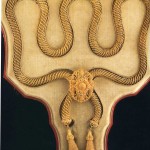 The chain was a particularly Georgian piece of jewelry. It could be woven, knitted, engraved or stamped out links. It would frequently feature a distinctive clasp. There was a seemingly endless array of option. Besides the gold, the chains were made out of silver and other materials such as iron, steel, gilt metal and pinchbeck.
The chain was a particularly Georgian piece of jewelry. It could be woven, knitted, engraved or stamped out links. It would frequently feature a distinctive clasp. There was a seemingly endless array of option. Besides the gold, the chains were made out of silver and other materials such as iron, steel, gilt metal and pinchbeck.
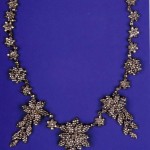 Steel was an interesting jewel choice during the Georgian period. The steel was fine cut and highly polished and primarily a night-time adornment as it reflected candle-glow particulary well. Queen Charlotte wore a cut-steel chain made by Matthew Boulton.
Steel was an interesting jewel choice during the Georgian period. The steel was fine cut and highly polished and primarily a night-time adornment as it reflected candle-glow particulary well. Queen Charlotte wore a cut-steel chain made by Matthew Boulton.
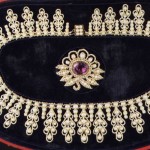 Seed pearls, tiny natural pearls from India were an essential part of Georgian jewelry. They were used in a variety of ways: long tasseled sautoirs, threaded into intricate designs on slides or clasps, used as surrounds for gemstones.
Seed pearls, tiny natural pearls from India were an essential part of Georgian jewelry. They were used in a variety of ways: long tasseled sautoirs, threaded into intricate designs on slides or clasps, used as surrounds for gemstones.
Iron is probably not the first metal that jumps to mind when thinking about jewelry but black-lacquered cast iron jewelry was made by the Royal Berlin Foundry beginning in 1804 and became fashionable during the Napoleonic Wars. It was made by moulding shapes into wax, impressing them in fine sand and then filling the impressions with molten iron. Once cooled, it was usually lacquered black.
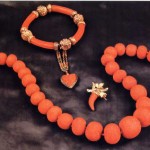 Coral had a brief period as jewelry desired for both day and evening wear. It came in the form of cameos, carved rosettes, acorns, or cherubs’ heads, and beads carved in facets or crosshatched. In the early 1800s it was even paired with diamonds for evening dress.
Coral had a brief period as jewelry desired for both day and evening wear. It came in the form of cameos, carved rosettes, acorns, or cherubs’ heads, and beads carved in facets or crosshatched. In the early 1800s it was even paired with diamonds for evening dress.
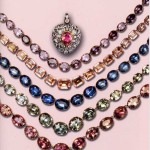 Paste – It’s more than just something to replace the jewels you’ve pawned to support your gambling habit. Much of the paste used in jewelry during the Georgian era was celebrated as jewels in their own right. Paste was highly regarded because the stones could be cut into any shape required for a setting. There are still some beautiful examples of fine paste jewelry.
Paste – It’s more than just something to replace the jewels you’ve pawned to support your gambling habit. Much of the paste used in jewelry during the Georgian era was celebrated as jewels in their own right. Paste was highly regarded because the stones could be cut into any shape required for a setting. There are still some beautiful examples of fine paste jewelry.
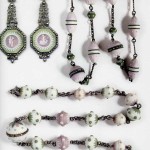 Wedgwood jewelry is distinctly English. Josiah Wedgwood’s ceramic-ware plaques were included in brooches, pendants, rings, buckles, clasps and earrings. Mathew Boulton of Birmingham used jasperware ceramic, with its soft matte finish set into gold, silver, marcasite or cut-steel. The beaded necklaces are particularly lovely.
Wedgwood jewelry is distinctly English. Josiah Wedgwood’s ceramic-ware plaques were included in brooches, pendants, rings, buckles, clasps and earrings. Mathew Boulton of Birmingham used jasperware ceramic, with its soft matte finish set into gold, silver, marcasite or cut-steel. The beaded necklaces are particularly lovely.

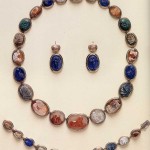
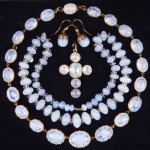


This book is on my wish list !! I really need to do a little judicial budgeting and buy it. LOVE these photos. I’m especially intrigued by the jewels in materials we would not consider for this era – steel, iron.
I have custody of a lovely set of Wedgewood jewelry my father bought for my mother when he toured the Wedgewood factory in England. I usually wear them to the Beau Monde soiree – a necklace, earrings and ring in the blue Wedgewood pattern. That is usually the only time I wear them as they are beyond precious to me.
I love the look of the Wedgwood jewelry. How appropriate for the Beau Monde soiree.
Thank you so much for the wonderful eye candy post this weekend, Myretta!! I have this book too, and absolutely love it. Some day, I would love a Georgian garnet and pearl bracelet…
Thanks, Myretta. Love the Wedgewood and the paste too. Sparkly!